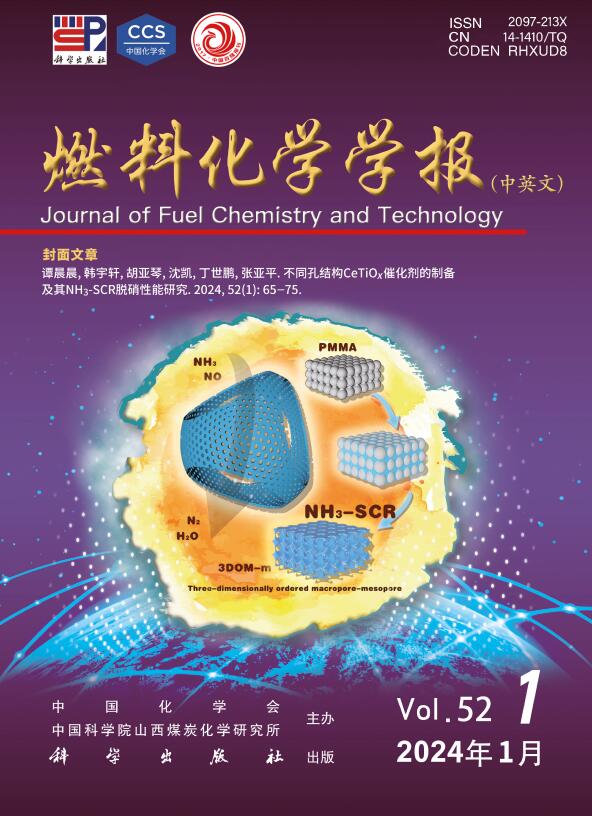Sc-doped strontium iron molybdenum cathode for high-efficiency CO2 electrolysis in solid oxide electrolysis cell
Q3 Energy
引用次数: 0
Abstract
Solid oxide electrolysis cells (SOECs) can effectively convert CO2 into high value-added CO fuel. In this paper, Sc-doped Sr2Fe1.5Mo0.3Sc0.2O6–δ (SFMSc) perovskite oxide material is synthesized via solid-phase method as the cathode for CO2 electrolysis by SOECs. XRD confirms that SFMSc exhibits a stable cubic phase crystal structure. The experimental results of TPD, TG, EPR, CO2-TPD further demonstrate that Sc-doping increases the concentration of oxygen vacancy in the material and the chemical adsorption capacity of CO2 molecules. Electrochemical tests reveal that SFMSc single cell achieves a current density of 2.26 A/cm2 and a lower polarization impedance of 0.32 Ω·cm2 at 800 °C under the applied voltage of 1.8 V. And no significant performance attenuation or carbon deposition is observed after 80 h continuous long-term stability test. This study provides a favorable support for the development of SOEC cathode materials with good electro-catalytic performance and stability.
固体氧化物电解池中用于高效CO2电解的掺sc锶铁钼阴极
固体氧化物电解电池(SOECs)可以有效地将CO2转化为高附加值的CO燃料。本文采用固相法合成了掺sc的Sr2Fe1.5Mo0.3Sc0.2O6 -δ (SFMSc)钙钛矿氧化物材料,作为soec电解CO2的阴极。XRD证实SFMSc具有稳定的立方相晶体结构。TPD、TG、EPR、CO2-TPD的实验结果进一步表明,sc掺杂增加了材料中氧空位的浓度,提高了CO2分子的化学吸附能力。电化学测试表明,在800℃下,在1.8 V电压下,SFMSc单体电池的电流密度为2.26 a /cm2,极化阻抗为0.32 Ω·cm2。经过连续80 h的长期稳定性试验,未见明显的性能衰减和积碳现象。该研究为开发具有良好电催化性能和稳定性的SOEC正极材料提供了有利的支持。
本文章由计算机程序翻译,如有差异,请以英文原文为准。
求助全文
约1分钟内获得全文
求助全文
来源期刊

燃料化学学报
Chemical Engineering-Chemical Engineering (all)
CiteScore
2.80
自引率
0.00%
发文量
5825
期刊介绍:
Journal of Fuel Chemistry and Technology (Ranliao Huaxue Xuebao) is a Chinese Academy of Sciences(CAS) journal started in 1956, sponsored by the Chinese Chemical Society and the Institute of Coal Chemistry, Chinese Academy of Sciences(CAS). The journal is published bimonthly by Science Press in China and widely distributed in about 20 countries. Journal of Fuel Chemistry and Technology publishes reports of both basic and applied research in the chemistry and chemical engineering of many energy sources, including that involved in the nature, processing and utilization of coal, petroleum, oil shale, natural gas, biomass and synfuels, as well as related subjects of increasing interest such as C1 chemistry, pollutions control and new catalytic materials. Types of publications include original research articles, short communications, research notes and reviews. Both domestic and international contributors are welcome. Manuscripts written in Chinese or English will be accepted. Additional English titles, abstracts and key words should be included in Chinese manuscripts. All manuscripts are subject to critical review by the editorial committee, which is composed of about 10 foreign and 50 Chinese experts in fuel science. Journal of Fuel Chemistry and Technology has been a source of primary research work in fuel chemistry as a Chinese core scientific periodical.
 求助内容:
求助内容: 应助结果提醒方式:
应助结果提醒方式:


